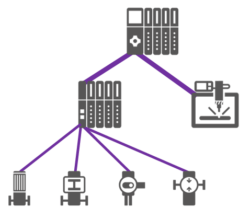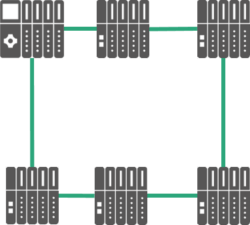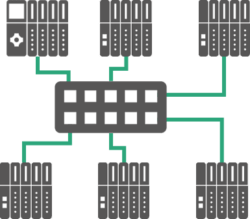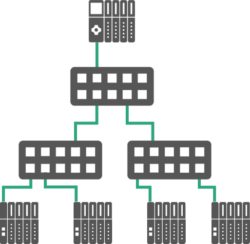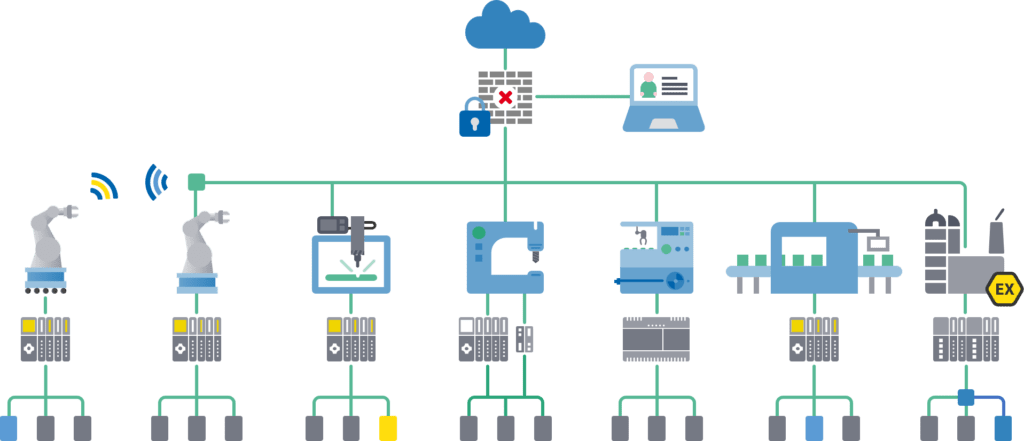What is the difference between PROFIBUS and PROFINET? We get this question fairly often. This article covers a comparison between PROFIBUS and PROFINET.
In short:
PROFIBUS is a classic serial Fieldbus, and PROFINET is an industrial Ethernet protocol. PROFIBUS and PROFINET are both IEC standards created by the same organization: PROFIBUS and PROFINET International. Because of their common source, PROFIBUS and PROFINET do share some similarities. But generally, they are very different.
Everything started with PROFIBUS, introduced in 1989, and grew rapidly in the 90s. Then, as the industry shifted from fieldbuses to Industrial Ethernet, PI developed PROFINET, which became available in the early 2000s, and has grown rapidly ever since.
Fundamental Differences between PROFIBUS and PROFINET
PROFIBUS networks are generally characterized by purple single-pair RS-485 cabling. And those cables use the standard DB9 or M12 connectors. PROFINET networks, on the other hand, typically use green industrially graded Ethernet cables. For PROFINET networks, the most common connector type is RJ45, but M12 connectors are also used in high exposure environments and BFOCs for fiber optic applications.
Overview: PROFIBUS and PROFINET Networks
PROFIBUS Networks
PROFIBUS is based on RS-485, which is a common serial communication method. In a PROFIBUS network, you have PROFIBUS masters and PROFIBUS devices. The master can be, for example, a PLC, PAC, or DCS. And the devices can be a wide array of devices: drives, motors, IOs, sensors, field devices, robots, actuators, and more.
PROFIBUS has two flavors: PROFIBUS Decentralised Peripherals (DP) and PROFIBUS Process Automation (PA). The general principle of PROFIBUS is collecting multiple inputs and outputs from the field into a local IO device, and then transferring the data through just one cable to the master. This approach saves costs by the omission of additional hardware and cabling. Also, it saves engineering time as it streamlines network installation, maintenance, and troubleshooting. The graph below illustrates the PROFIBUS DP concept. Also, it includes a PROFIBUS PA section for hazardous environments.
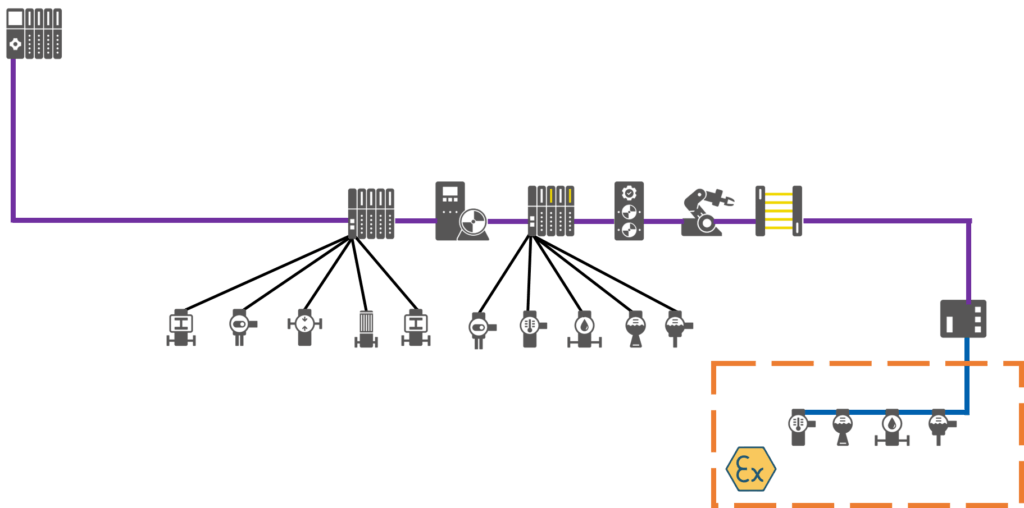 PROFIBUS PA is the same PROFIBUS DP protocol but based on a different physical layer: Manchester Bus Powered (MBP). PROFIBUS PA is proven for use in explosive areas where intrinsic safety is required.
PROFIBUS PA is the same PROFIBUS DP protocol but based on a different physical layer: Manchester Bus Powered (MBP). PROFIBUS PA is proven for use in explosive areas where intrinsic safety is required.
When installing a PROFIBUS network, users link each device to the next in a process commonly referred to as daisy-chaining, resulting in a line topology. Also, they can employ star or tree topologies for more advanced configurations, although this is less common. Besides, PROFIBUS messages can be transmitted wirelessly, but they require proprietary radios from the same maker at both ends.
- Line / Línea
- Star / Estrella
- Tree / Árbol
For a complete overview of PROFIBUS, you can take our free PROFIBUS Online Training Course. This course prepares students to apply PROFIBUS in their own projects. It covers network design, configuration, installation, commissioning, and maintenance.
PROFINET Networks
PROFINET is based on standard Ethernet, the same Ethernet that you might have encountered in your home or office. Standard Ethernet cables are suitable for PROFINET networks. However, most users employ PROFINET cables, which are just Ethernet cables but ruggedized, built to withstand the rough environment of a factory. Just like with PROFIBUS, in a PROFINET network, you have PLCs, PACs, and DCSs and also sensors, actuators, robots, RFID readers, and other IOs. In PROFINET, however, we call these controllers and devices, respectively.
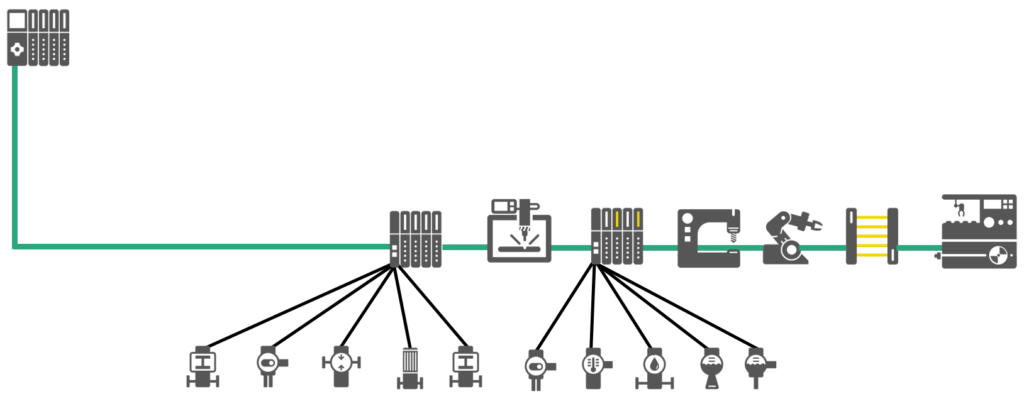
Similarly to PROFIBUS, PROFINET also allows users to save in wiring and installation costs by using distributed IO mechanisms. PROFINET users have more flexibility when designing a network. There is a variety of topology options: line, star, tree, and ring. Also, since PROFINET networks are based on Ethernet, specialized switches are not required. You can utilize standard Ethernet switches to implement flexible topology options cost-effectively. The only requirement for switches is 100 Mbps, full-duplex. Also, it is possible to implement wireless-based configurations with PROFINET. PROFINET supports WLAN and Bluetooth as part of its specification. Therefore, it enables wireless connections without limitations, even with safety messages (PROFIsafe).
- Anillo
- Estrella
- Árbol
- Línea
Technical Comparison: PROFIBUS vs PROFINET
PROFIBUS networks (based on RS-485) can achieve speeds of up to 12 Mbit/s, though most run at 1.5 Mbit/s. The telegram size can be up to 244 bytes, and the address space is limited to 126 devices per network. PROFINET networks achieve speeds of 100 Mbit/s or even 1 Gbit/s and higher. The telegram size can be up to 1440 bytes, and there are no limits on the address space. Although the specification does not limit the address space, individual controllers will have restrictions based on their processor and memory.
The move from RS-485 to Ethernet is a move to more modern technology. Because PROFINET just uses standard Ethernet, it is future-proof; as commercial Ethernet advances, PROFINET takes advantage. For example, when PROFINET started, 100 Mbit/s Ethernet was standard. Currently, PROFINET can run just as smoothly on today’s Gigabit Ethernet (and higher). The move to an Ethernet base provides for higher bandwidth, larger message size, and unlimited address space.
Data Exchange Mechanism
Another critical difference between PROFIBUS and PROFINET is the data exchange mechanism.PROFIBUS employs a master-device interaction, whereas PROFINET uses a consumer provider model.
In a master-device interaction, the master has unidirectional control over all its devices and processes. The controller will always be the master, and the IO devices will always be devices. The consumer provider model is more flexible. In PROFINET networks, controllers and IO devices can both assume consumer and provider roles, leveraging the full duplex nature of Ethernet. The controller provides output data to the configured IO devices in its role as provider and is the consumer of input data from IO devices. The IO device is the provider of input data and the consumer of output data.
Gateways and Proxies
Individual companies have created gateways to do the translations from other networks to PROFIBUS. PROFINET has gone one step further by defining proxies in its own specification. Proxies are like gateways in that they translate one network to another, but unlike gateways, they are defined in an open standard. PROFINET has available proxies for PROFIBUS DP, PROFIBUS PA, AS-i, IO-Link, DeviceNet, Foundation Fieldbus, CANopen, Modbus, HART, and more. For example, IO-Link and AS-i proxies allow communication to smart devices without an Ethernet port.
Comparison Summary
The following table summarizes most of the technical differences and similarities between PROFIBUS and PROFINET:
| PROFIBUS | PROFINET | |
| Organization | PI | |
| Application Profiles | same | |
| Concepts | Engineering, GSDs | |
| Physical layer | RS-485 | Ethernet |
| Speed | 12Mbit/s | 1Gbit/s or 100Mbit/s |
| Telegram | 244 bytes | 1440 bytes (cyclic)* |
| Address space | 126 | unlimited |
| Technology | master/device | provider/consumer |
| Connectivity | PA + others* | many buses |
| Wireless | possible** | IEEE 802.11, 15.1 |
| Motion | 32 axes | >150 axes |
| Machine-to-Machine | No | Yes |
| Vertical Integration | No | Yes |
| *With multiple telegrams: up to 232-65 (acyclic) | ||
| **Not in the specification, but solutions available | ||
Presence in the Industry
There are many substantial differences between PROFIBUS and PROFINET. Yet, PROFIBUS and PROFINET are both well-proven industry leaders. They are both suitable to fulfill complex automation requirements in discrete, process, hybrid, and motion control applications.
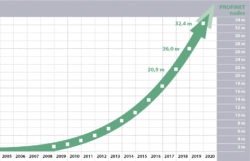 Thousands of device manufacturers develop and produce products available with either a PROFIBUS or PROFINET interface. As of 2019, there were over 32 million PROFINET nodes and 60 million PROFIBUS nodes installed worldwide. It makes sense that PROFIBUS is more prevalent. PROFINET is the younger technology, and when it was introduced, there were already tens of millions of installed PROFIBUS devices. Between the two, PROFINET is the clear winner from a technical and investment-protection perspective. Today, the adoption of PROFINET is growing exponentially, and in some years, its adoption will surpass PROFIBUS. But even then, PROFIBUS will still be an industry leader, and it will continue being the leading serial Fieldbus technology historically.
Thousands of device manufacturers develop and produce products available with either a PROFIBUS or PROFINET interface. As of 2019, there were over 32 million PROFINET nodes and 60 million PROFIBUS nodes installed worldwide. It makes sense that PROFIBUS is more prevalent. PROFINET is the younger technology, and when it was introduced, there were already tens of millions of installed PROFIBUS devices. Between the two, PROFINET is the clear winner from a technical and investment-protection perspective. Today, the adoption of PROFINET is growing exponentially, and in some years, its adoption will surpass PROFIBUS. But even then, PROFIBUS will still be an industry leader, and it will continue being the leading serial Fieldbus technology historically.
Which one should you implement?
When should you use one versus the other? Brownfield – use PROFIBUS. Greenfield – use PROFINET. A brownfield location that already has PROFIBUS can continue to add PROFIBUS nodes. Although if you need to add Ethernet functionality, it may pay to add a small projects-worth of PROFINET. For a greenfield opportunity, start with PROFINET – it’s the future!
If you would like to expand more on this content, we have created a document for you. Just follow this link to download our PROFIBUS vs. PROFINET white paper.
White paper: PROFIBUS vs PROFINET: Comparison and Migration Strategies



